Experimental Study on Optimization of Consolidation Parameters of Silty Clay Based on Response Surface Methodology: A Case Study on the Protection and Restoration of the Ming and Qing Dynasty Hangzhou Seawall Site
Abstract
:1. Introduction
2. Experimental Materials
2.1. Soil Samples from Seawall Site
2.2. Alkali-Activated Slag Cementitious Materials
3. Experimental Design
3.1. Response Surface Methodology Experimental Design
3.2. Experimental Method
3.2.1. Sample Preparation
3.2.2. Macroscopic Unconfined Compression Test
3.2.3. Microscopic Scanning Electron Microscope Experiment
4. Results and Discussion
4.1. Compressive Strength Test and Regression Fitting Model Analysis
4.2. Response Surface Model Analysis
5. Microstructural Analysis
6. Mechanism of Solidification Systems
7. Optimization of Process Parameters
8. Practical Approaches to the Restoration and Reinforcement of the Seawall Site
9. Conclusions
- The dosages of slag, lime, and gypsum significantly affect the linear growth rate of the 28-day compressive strength, and the interactions between lime and gypsum, as well as between lime and slag, significantly impact the compressive strength.
- The lime: gypsum: slag ratio of 1:1.9:6.2 achieves the optimum process parameters for the alkali-activated slag material, leading to the best solidification effect on the silty clay after 28 days.
- Microscopic observation of the optimized soil revealed that the formation of a substantial amount of amorphous calcium silicate hydrate and needle-like ettringite contributed to the enhancement of the compressive strength of the solidified soil. These substances tightly wrap around and fill the soil particles, constructing a three-dimensional network skeleton structure that reduces the porosity of the original soil and makes the soil structure more compact.
Author Contributions
Funding
Institutional Review Board Statement
Informed Consent Statement
Data Availability Statement
Conflicts of Interest
References
- Tao, C.; Zhou, C. The Qiantang River Seawall during the Ming and Qing Dynasties; China Water & Power Press: Beijing, China, 2001; p. 225. [Google Scholar]
- Zhao, P.; Jackson, M.D.; Zhang, Y.; Li, G.; Monteiro, P.J.; Yang, L. Material characteristics of ancient Chinese lime binder and experimental reproductions with organic admixtures. Constr. Build. Mater. 2015, 84, 477–488. [Google Scholar] [CrossRef]
- Pei, Q.Q.; Wang, X.D.; Guo, Q.L.; Zhao, L.; Zhang, B.; Li, Z.P. Action mechanism of sticky rice-paste-modified site soil: A traditional Chinese cementitious material. Stud. Conserv. 2020, 65, 238–250. [Google Scholar] [CrossRef]
- Wang, H.; Zhang, J.; Yan, X.; Xiong, R. Study on properties of magnesium oxychloride cement solidified soil. Adv. Mater. Sci. Eng. 2022, 2022, 5195450. [Google Scholar] [CrossRef]
- Cai, J.; Ding, B.; Yuan, Y.; Luo, X.; Gu, J.; Ukrainczyk, N.; Pan, J. Development of High-Performance Sticky Rice–Lime Composite with Metakaolin and Hemp Fibers. J. Mater. Civ. Eng. 2024, 36, 04024090. [Google Scholar] [CrossRef]
- Li, S.; Wang, D.; Wu, Y. Strength and load-bearing behaviors of cement-industrial by-products solidified crust layer over soft subsoil. Constr. Build. Mater. 2024, 412, 134744. [Google Scholar] [CrossRef]
- Mohammadi, E.L.; Najafi, E.K.; Ranjbar, P.Z.; Payan, M.; Chenari, R.J.; Fatahi, B. Recycling industrial alkaline solutions for soil stabilization by low-concentrated fly ash-based alkali cements. Constr. Build. Mater. 2023, 393, 132083. [Google Scholar] [CrossRef]
- Wang, S.; Wang, S.; Lu, Z.; Meng, Z.; Li, B.; Zhao, N. Revamp of the sticky rice-lime binder with metakaolin and natural fiber for restoration: Properties and characteristics. J. Cult. Herit. 2022, 57, 1–15. [Google Scholar] [CrossRef]
- Ministry of Science and Technology, Ministry of Culture, and State Administration of Cultural Heritage. Joint Issuance of the “National 13th Five-Year Plan for Cultural Heritage Protection and Public Cultural Service Science and Technology Innovation”. Herit. Prot. Res. 2017, 2, 126. [Google Scholar] [CrossRef]
- Cultural Relics Protection Law of the People’s Republic of China. 2008. Available online: https://flk.npc.gov.cn/detail2.html?MmM5MDlmZGQ2NzhiZjE3OTAxNjc4YmY4N2U1NjBhYjk (accessed on 15 August 2023).
- General Office of the State Council of the People’s Republic of China. Notice on the Issuance of the “14th Five-Year Plan for Cultural Relics Protection and Scientific and Technological Innovation” (State Office [2021] No. 43). Gaz. State Counc. People’s Repub. China; 2021; pp. 21–36. Available online: https://www.gov.cn/xinwen/2021-11/08/content_5649838.htm (accessed on 30 September 2023).
- Dong, W.; Zhan, Q.; Zhao, X.; Wang, A.; Zhang, Y. Study on the solidification property and mechanism of soft soil based on the industrial waste residue. Rev. Adv. Mater. Sci. 2023, 62, 20220303. [Google Scholar] [CrossRef]
- Geng, K.; Chai, J.; Qin, Y.; Xu, Z.; Cao, J.; Zhou, H.; Zhang, X. Damage evolution, brittleness and solidification mechanism of cement soil and alkali-activated slag soil. J. Mater. Res. Technol. 2023, 25, 6039–6060. [Google Scholar] [CrossRef]
- Ahmad, J.; Kontoleon, K.J.; Majdi, A.; Naqash, M.T.; Deifalla, A.F.; Ben Kahla, N.; Isleem, H.F.; Qaidi, S.M. A comprehensive review on the ground granulated blast furnace slag (GGBS) in concrete production. Sustainability 2022, 14, 8783. [Google Scholar] [CrossRef]
- Acharya, A.; Archroy, S.; Gokhale, V.A. Role of additives in mortars: Historic precedents. Int. J. Eng. Res. Appl. 2017, 7, 7–12. [Google Scholar] [CrossRef]
- Sekar, P.; Alluri, S.K.R. Impact of Cyclones and Surge on Slope Stability of Rubble Mound Seawall. In Proceedings of the OCEANS 2022-Chennai, Chennai, India, 21–24 February 2022; pp. 1–5. [Google Scholar]
- Chen, Q.; Tu, X.; Lv, Y.; Liu, W.; Shi, L. Experimental study on vertical bearing and deformation characteristics of Qiantang river ancient seawall. Buildings 2023, 13, 2788. [Google Scholar] [CrossRef]
- Chang, T.; Zhan, L.; Tan, W.; Li, S. Optimization of curing process for polymer-matrix composites based on orthogonal experimental method. Fibers Polym. 2017, 18, 148–154. [Google Scholar] [CrossRef]
- Li, Y.; Jia, S.; Liu, J. Solidification, remediation and long-term stability of heavy metal contaminated soil under the background of sustainable development. Sci. Rep. 2022, 12, 10330. [Google Scholar] [CrossRef] [PubMed]
- Shang, Y.; Cui, Z.; Zhang, Y. Experimental Study on the Synergistic Solidification of Soft Soil with Ceramic Powder–Slag–Phosphorus Slag. Sustainability 2023, 15, 15474. [Google Scholar] [CrossRef]
- Wang, X.-K.; Pang, J.-Y.; Wang, Q. Orthogonal Experimental Studies on Unconfined Compressive Strength of Composite Cement-soil. J. Yangtze River Sci. Res. Inst. 2015, 32, 72. [Google Scholar]
- Zhang, H.; Li, L.; Sarker, P.K.; Long, T.; Shi, X.; Wang, Q.; Cai, G. Investigating various factors affecting the long-term compressive strength of heat-cured fly ash geopolymer concrete and the use of orthogonal experimental design method. Int. J. Concr. Struct. Mater. 2019, 13, 63. [Google Scholar] [CrossRef]
- Liu, R.J.; Zhang, Y.W.; Wen, C.W.; Tang, J. Study on the design and analysis methods of orthogonal experiment. Exp. Technol. Manag. 2010, 27, 52–55. [Google Scholar]
- Ihueze, C.; Obiuto, C.; Okafor, C.E.; Okpala, C.C. Orthogonal array application and response surface method approach for optimal product values: An application for Oil blending process. World Acad. Sci. Eng. Technol. 2013, 76, 610–614. [Google Scholar]
- Li, Z.; Lu, D.; Gao, X. Optimization of mixture proportions by statistical experimental design using response surface method- A review. J. Build. Eng. 2021, 36, 102101. [Google Scholar] [CrossRef]
- Edwards, I.; Jutan, A. Optimization and control using response surface methods. Comput. Chem. Eng. 1997, 21, 441–453. [Google Scholar] [CrossRef]
- Khuri, A.I. Response surface methodology and its applications in agricultural and food sciences. Biom. Biostat. Int. J. 2017, 5, 155–163. [Google Scholar] [CrossRef]
- Alyamac, K.E.; Ghafari, E.; Ince, R. Development of eco-efficient self-compacting concrete with waste marble powder using the response surface method. J. Clean. Prod. 2017, 144, 192–202. [Google Scholar] [CrossRef]
- Anwar, M.; Rasul, M.G.; Ashwath, N.; Rahman, M.M. Optimisation of second-generation biodiesel production from Australian native stone fruit oil using response surface method. Energies 2018, 11, 2566. [Google Scholar] [CrossRef]
- Kakavandi, B.; Takdastan, A.; Jaafarzadeh, N.; Azizi, M.; Mirzaei, A.; Azari, A. Application of Fe3O4@ C catalyzing heterogeneous UV-Fenton system for tetracycline removal with a focus on optimization by a response surface method. J. Photochem. Photobiol. A Chem. 2016, 314, 178–188. [Google Scholar] [CrossRef]
- Dao, T.A.T.; Webb, H.K.; Malherbe, F. Optimization of pectin extraction from fruit peels by response surface method: Conventional versus microwave-assisted heating. Food Hydrocoll. 2021, 113, 106475. [Google Scholar]
- Penkhrue, W.; Jendrossek, D.; Khanongnuch, C.; Pathom-Aree, W.; Aizawa, T.; Behrens, R.L.; Lumyong, S. Response surface method for polyhydroxybutyrate (PHB) bioplastic accumulation in Bacillus drentensis BP17 using pineapple peel. PLoS ONE 2020, 15, e0230443. [Google Scholar] [CrossRef] [PubMed]
- St-Pierre, N.R.; Weiss, W.P. Technical note: Designing and analyzing quantitative factorial experiments. J. Dairy Sci. 2009, 92, 4581–4588. [Google Scholar] [CrossRef]


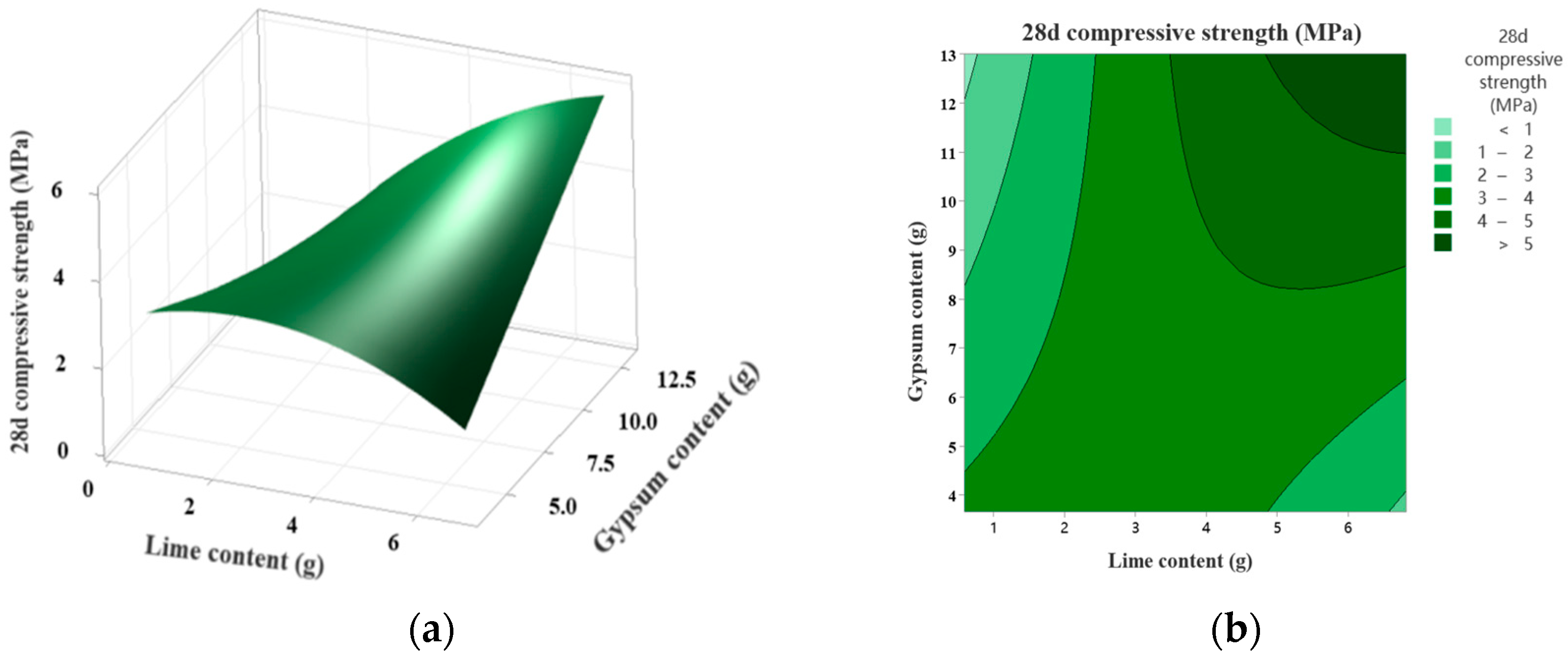

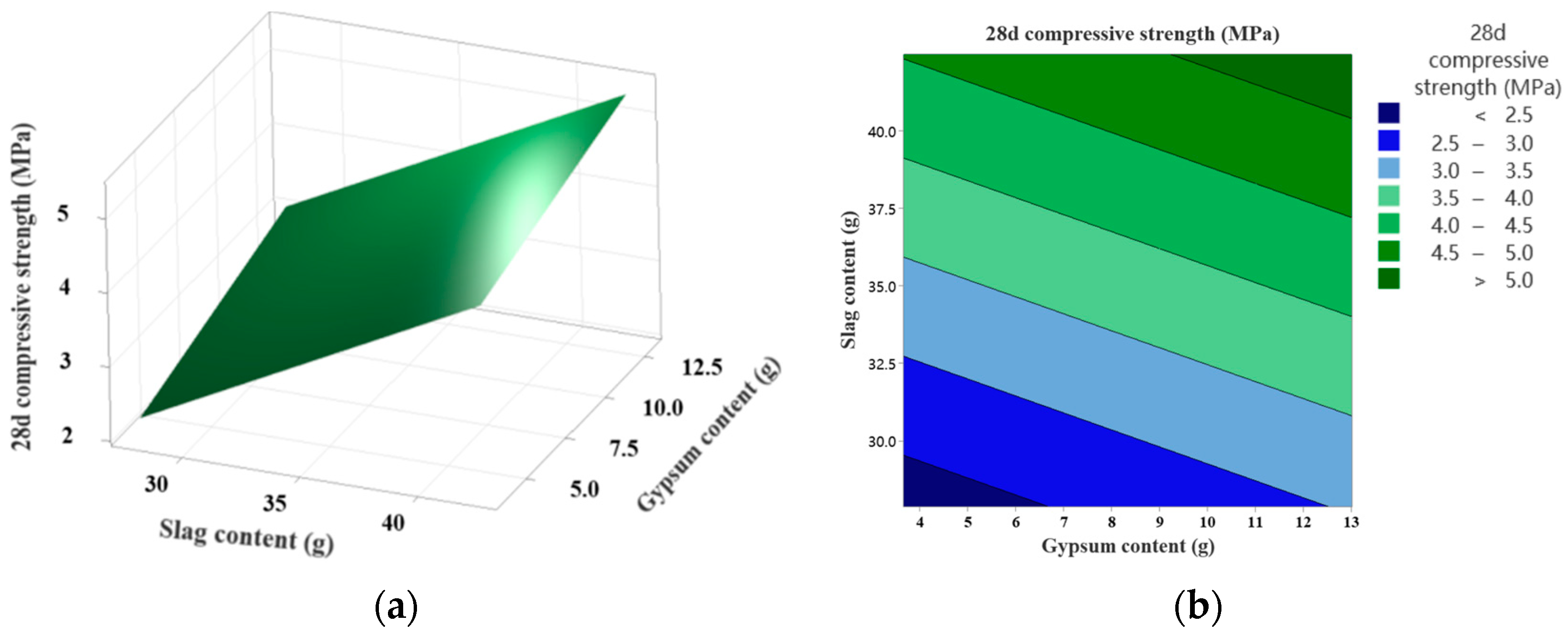


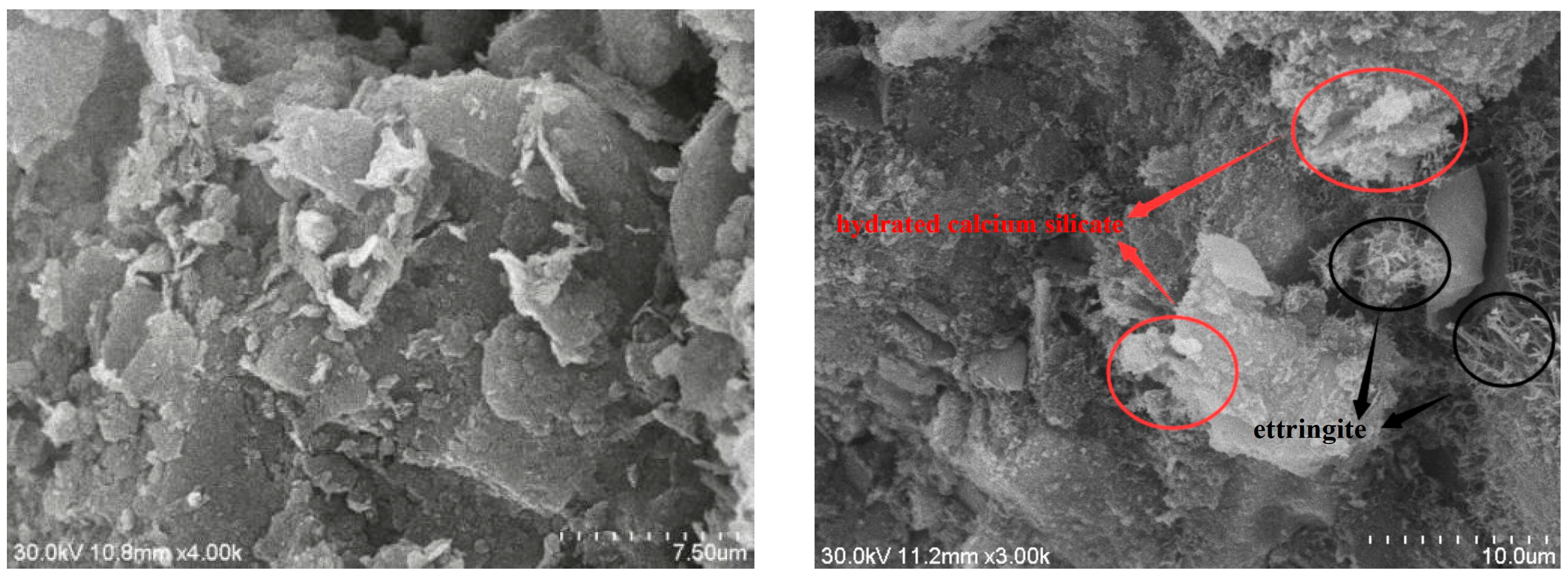

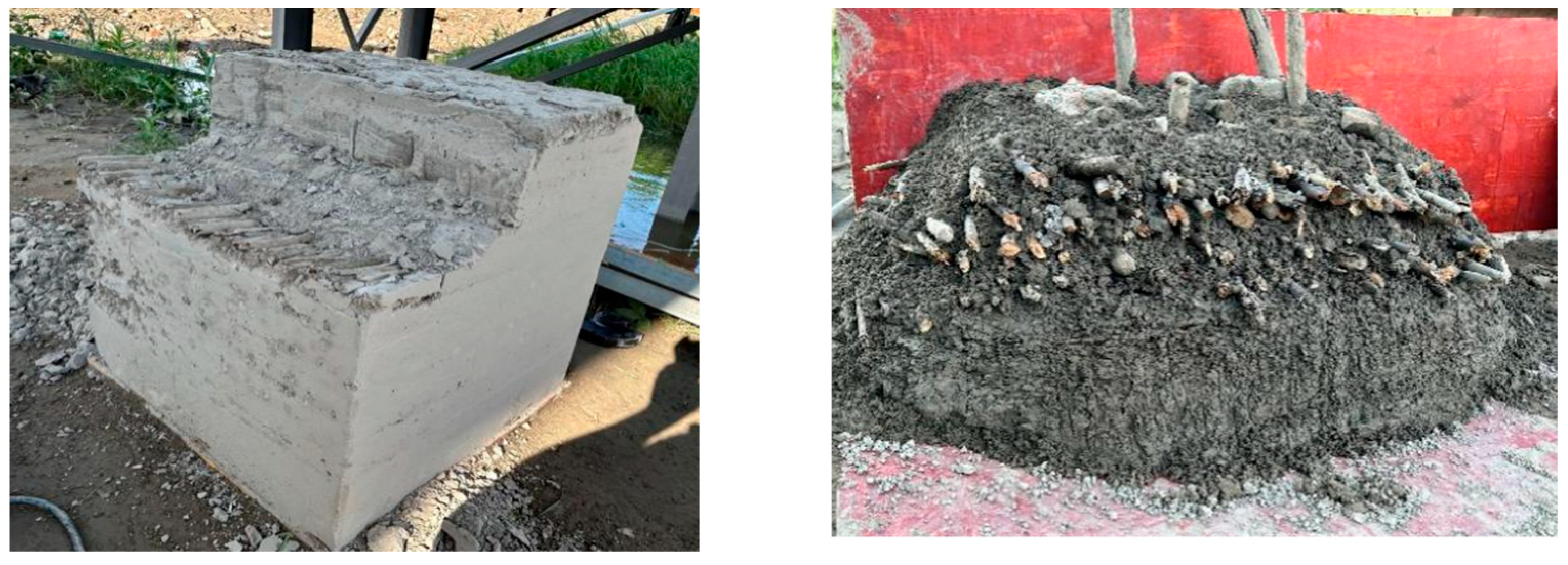
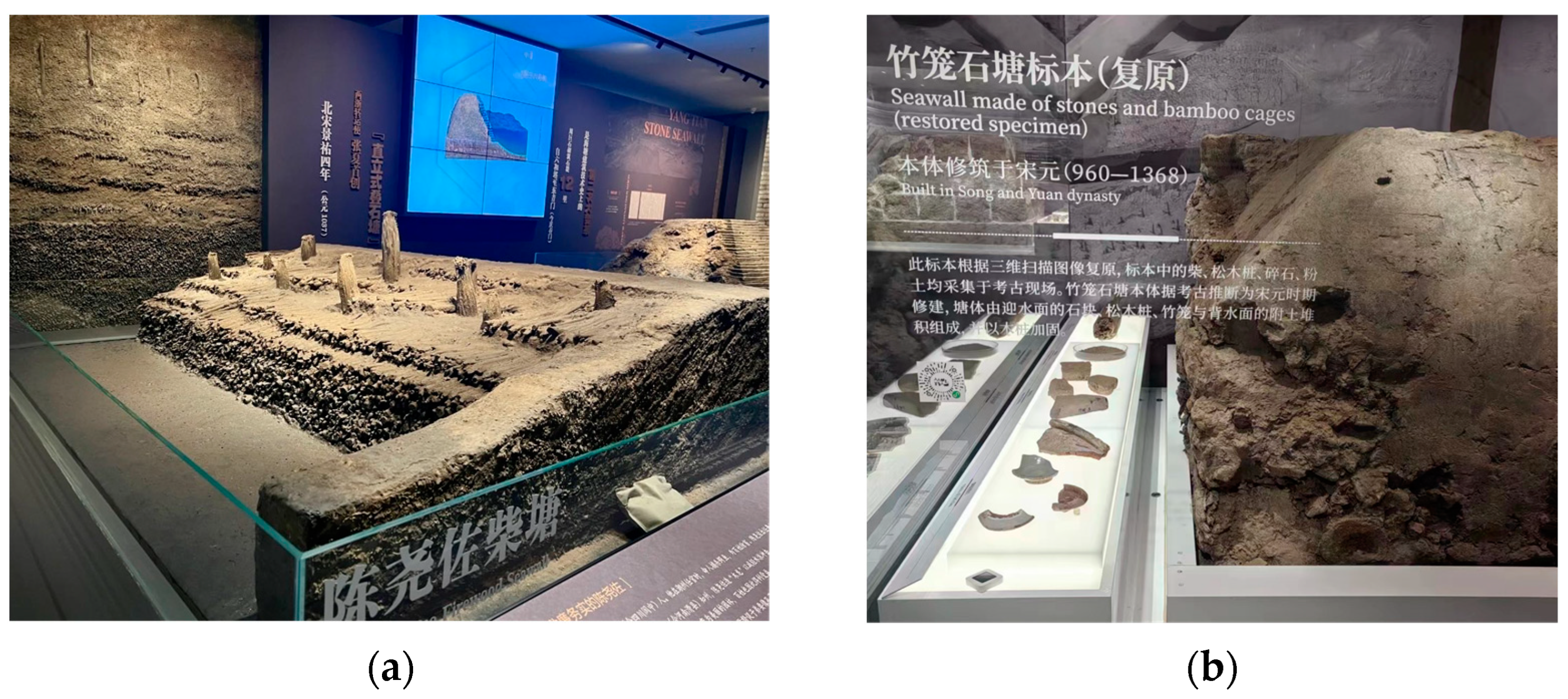
| Moisture Content /% | Wet Density (g·cm−3) | Dry Density (g·cm−3) | Relative Density | Specific Gravity of Soil Particles | Plastic Limit /% | Liquid Limit /% | Plasticity Index | Liquidity Index |
|---|---|---|---|---|---|---|---|---|
| 34.2 | 2.124 | 1.66 | 0.11 | 1.916 | 18.68 | 32.65 | 13.970 | 1.111 |
| Oxide Composition | SiO2 | Al2O3 | Fe2O3 | CaO | K2O | MgO | TiO2 | Na2O | Others |
|---|---|---|---|---|---|---|---|---|---|
| Content (%) | 65.45 | 9.59 | 8.41 | 6.56 | 4.14 | 2.05 | 1.61 | 1.29 | 0.9 |
| Variables | Code | Unencoded Value (g) | Coded Levels and Corresponding Uncoded Values | ||||
|---|---|---|---|---|---|---|---|
| −1.682 | −1 | 0 | +1 | +1.682 | |||
| Lime | X1 | W1 | 0.589 | 1.851 | 3.703 | 5.556 | 6.818 |
| Gypsum | X2 | W2 | 3.659 | 5.554 | 8.333 | 11.113 | 13.007 |
| Slag | X3 | W3 | 27.879 | 30.833 | 35.167 | 39.500 | 42.454 |
| No. | X1 | X2 | X3 | Y/MPa |
|---|---|---|---|---|
| 1 | 0 | 0 | 0 | 4.10 |
| 2 | 1 | −1 | 1 | 3.94 |
| 3 | −1 | −1 | −1 | 2.66 |
| 4 | 0 | 0 | 0 | 3.96 |
| 5 | −1.682 | 0 | 0 | 1.96 |
| 6 | −1 | 1 | 1 | 3.62 |
| 7 | 0 | 0 | 0 | 3.78 |
| 8 | 0 | 0 | 0 | 3.67 |
| 9 | 1 | 1 | 1 | 5.21 |
| 10 | −1 | −1 | 1 | 3.97 |
| 11 | −1 | 1 | −1 | 1.47 |
| 12 | 1 | 1 | −1 | 4.42 |
| 13 | 0 | 0 | 0 | 3.74 |
| 14 | 0 | 0 | −1.682 | 2.55 |
| 15 | 0 | 0 | +1.682 | 4.74 |
| 16 | +1.682 | 0 | 1 | 3.84 |
| 17 | 0 | 0 | 1 | 3.86 |
| 18 | 0 | +1.682 | 1 | 4.18 |
| 19 | 1 | −1 | −1 | 2.60 |
| 20 | 0 | −1.682 | 0 | 3.17 |
| Response | 28d Compressive Strength | |||
|---|---|---|---|---|
| Source | Adj SS | Adj MS | F-Value | p-Value |
| Model | 15.6499 | 1.73888 | 38.90 | <0.0001 |
| X1 | 4.2425 | 4.24249 | 94.90 | <0.0001 |
| X2 | 0.7728 | 0.77276 | 17.29 | 0.0002 |
| X3 | 6.2965 | 6.29654 | 140.85 | <0.0001 |
| X1X1 | 1.4269 | 1.42067 | 31.78 | <0.0001 |
| X2X2 | 0.0230 | 0.02302 | 0.52 | 0.489 |
| X3X3 | 0.0369 | 0.03687 | 0.82 | 0.385 |
| X1X2 | 2.6796 | 2.67961 | 59.94 | <0.0001 |
| X1X3 | 0.2211 | 0.22111 | 4.95 | 0.050 |
| X2X3 | 0.0105 | 0.01051 | 0.24 | 0.638 |
| Lack of Fit | 0.3229 | 0.06459 | 2.60 | 0.159 |
| Model | S | R-sq | R-sq(adj) | R-sq(pred) |
|---|---|---|---|---|
| 28d | 0.198491 | 96.82% | 95.35% | 90.26% |
| No. | V28d | V28d pred | Δ28d |
|---|---|---|---|
| 1 | 4.10 | 3.78 | 7.79% |
| 2 | 3.94 | 3.73 | 5.37% |
| 3 | 2.66 | 2.41 | 9.28% |
| 4 | 3.96 | 3.78 | 4.53% |
| 5 | 1.96 | 1.98 | 0.95% |
| 6 | 3.62 | 3.42 | 5.47% |
| 7 | 3.78 | 3.78 | 0.02% |
| 8 | 3.67 | 3.78 | 3.02% |
| 9 | 5.21 | 5.36 | 2.91% |
| 10 | 3.97 | 4.10 | 3.37% |
| 11 | 1.47 | 1.73 | 17.79% |
| 12 | 4.42 | 4.34 | 1.90% |
| 13 | 3.74 | 3.78 | 1.09% |
| 14 | 2.55 | 2.64 | 3.48% |
| 15 | 4.74 | 4.92 | 3.86% |
| 16 | 3.84 | 3.85 | 0.35% |
| 17 | 3.86 | 3.78 | 2.05% |
| 18 | 4.18 | 4.18 | 0.02% |
| 19 | 2.60 | 2.70 | 3.96% |
| 20 | 3.17 | 3.38 | 6.65% |
| Average | 4.19% |
| Model | Lime/ (g) | Gypsum/ (g) | Slag/ (g) | Compressive Strength Predicted Value/(Mpa) | Standard Error of Fitting Value | 95% Confidence Interval | 95% Predicted Interval |
|---|---|---|---|---|---|---|---|
| 28d | 6.818 | 13.007 | 42.454 | 6.936 | 0.356 | (6.166, 7.706) | (6.046, 7.825) |
| Age | No. | Compressive Strength (Mpa) | Relative Error to Fitting (%) | Average Relative Error (%) |
|---|---|---|---|---|
| 28d | 1 | 6.74 | 2.91% | 2.92% |
| 2 | 7.33 | 5.38% | ||
| 3 | 6.97 | 0.49% |
| Subject | No. | L | a | b | c | h |
|---|---|---|---|---|---|---|
| Original Soil | 1 | 44.64 | 5.24 | 23.22 | 23.75 | 77.85 |
| 2 | 47.21 | 4.83 | 24.01 | 22.93 | 78.11 | |
| 3 | 49.12 | 4.91 | 22.94 | 24.47 | 77.54 | |
| 4 | 48.71 | 5.35 | 23.18 | 23.12 | 77.84 | |
| 5 | 45.33 | 5.17 | 24.13 | 22.42 | 76.64 | |
| Average | 47.002 | 5.100 | 23.496 | 23.338 | 77.596 | |
| Solidified Soil | 1 | 62.29 | 4.29 | 18.56 | 19.05 | 76.98 |
| 2 | 53.82 | 4.15 | 17.38 | 17.87 | 76.59 | |
| 3 | 59.40 | 4.59 | 19.94 | 19.48 | 76.36 | |
| 4 | 55.24 | 4.33 | 17.99 | 18.50 | 76.48 | |
| 5 | 60.5 | 4.47 | 18.23 | 18.77 | 76.23 | |
| Average | 58.25 | 4.366 | 18.420 | 18.734 | 76.528 |
Disclaimer/Publisher’s Note: The statements, opinions and data contained in all publications are solely those of the individual author(s) and contributor(s) and not of MDPI and/or the editor(s). MDPI and/or the editor(s) disclaim responsibility for any injury to people or property resulting from any ideas, methods, instructions or products referred to in the content. |
© 2024 by the authors. Licensee MDPI, Basel, Switzerland. This article is an open access article distributed under the terms and conditions of the Creative Commons Attribution (CC BY) license (https://creativecommons.org/licenses/by/4.0/).
Share and Cite
Ye, L.; Chen, Z.; Wu, L.; Zou, B. Experimental Study on Optimization of Consolidation Parameters of Silty Clay Based on Response Surface Methodology: A Case Study on the Protection and Restoration of the Ming and Qing Dynasty Hangzhou Seawall Site. Sustainability 2024, 16, 8219. https://doi.org/10.3390/su16188219
Ye L, Chen Z, Wu L, Zou B. Experimental Study on Optimization of Consolidation Parameters of Silty Clay Based on Response Surface Methodology: A Case Study on the Protection and Restoration of the Ming and Qing Dynasty Hangzhou Seawall Site. Sustainability. 2024; 16(18):8219. https://doi.org/10.3390/su16188219
Chicago/Turabian StyleYe, Liang, Zhenyan Chen, Liquan Wu, and Baoping Zou. 2024. "Experimental Study on Optimization of Consolidation Parameters of Silty Clay Based on Response Surface Methodology: A Case Study on the Protection and Restoration of the Ming and Qing Dynasty Hangzhou Seawall Site" Sustainability 16, no. 18: 8219. https://doi.org/10.3390/su16188219





